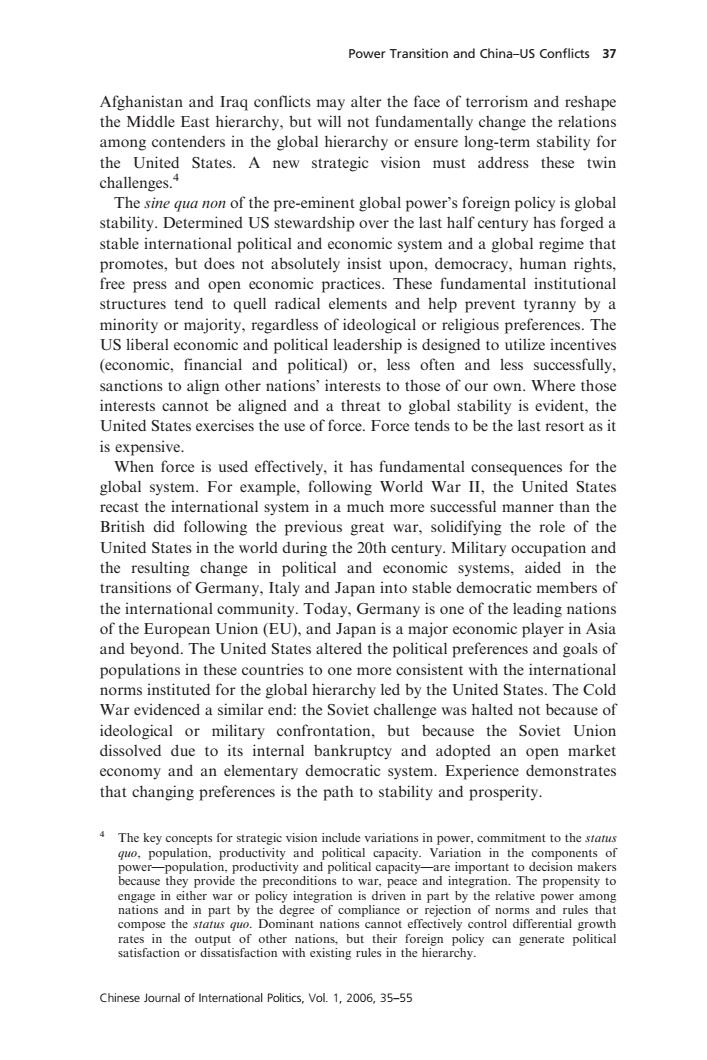正在加载图片...

Power Transition and China-US Conflicts 37 Afghanistan and Irag conflicts may alter the face of terrorism and reshape the Middle East hierarchy,but will not fundamentally change the relations among contenders in the global hierarchy or ensure long-term stability for the United States.A new strategic vision must address these twin challenges.4 The sine qua non of the pre-eminent global power's foreign policy is global stability.Determined US stewardship over the last half century has forged a stable international political and economic system and a global regime that promotes,but does not absolutely insist upon,democracy,human rights, free press and open economic practices.These fundamental institutional structures tend to quell radical elements and help prevent tyranny by a minority or majority,regardless of ideological or religious preferences.The US liberal economic and political leadership is designed to utilize incentives (economic,financial and political)or,less often and less successfully. sanctions to align other nations'interests to those of our own.Where those interests cannot be aligned and a threat to global stability is evident,the United States exercises the use of force.Force tends to be the last resort as it is expensive. When force is used effectively,it has fundamental consequences for the global system.For example,following World War II,the United States recast the international system in a much more successful manner than the British did following the previous great war,solidifying the role of the United States in the world during the 20th century.Military occupation and the resulting change in political and economic systems,aided in the transitions of Germany,Italy and Japan into stable democratic members of the international community.Today,Germany is one of the leading nations of the European Union(EU),and Japan is a major economic player in Asia and beyond.The United States altered the political preferences and goals of populations in these countries to one more consistent with the international norms instituted for the global hierarchy led by the United States.The Cold War evidenced a similar end:the Soviet challenge was halted not because of ideological or military confrontation,but because the Soviet Union dissolved due to its internal bankruptcy and adopted an open market economy and an elementary democratic system.Experience demonstrates that changing preferences is the path to stability and prosperity. 4 The key concepts for strategic vision include variations in power,commitment to the stats quo,population,productivity and political capacity.Variation in the components of power-population.productivity and political capacity-are important to decision makers because they provide the preconditions to war.peace and integration.The propensity to engage in either war or policy integration is driven in part by the relative power among nations and in part by the degree of compliance or rejection of norms and rules that compose the status quo.Dominant nations cannot effectively control differential growth rates in the output of other nations,but their foreign policy can generate political satisfaction or dissatisfaction with existing rules in the hierarchy. Chinese Journal of International Politics,Vol.1,2006,35-55Afghanistan and Iraq conflicts may alter the face of terrorism and reshape the Middle East hierarchy, but will not fundamentally change the relations among contenders in the global hierarchy or ensure long-term stability for the United States. A new strategic vision must address these twin challenges.4 The sine qua non of the pre-eminent global power’s foreign policy is global stability. Determined US stewardship over the last half century has forged a stable international political and economic system and a global regime that promotes, but does not absolutely insist upon, democracy, human rights, free press and open economic practices. These fundamental institutional structures tend to quell radical elements and help prevent tyranny by a minority or majority, regardless of ideological or religious preferences. The US liberal economic and political leadership is designed to utilize incentives (economic, financial and political) or, less often and less successfully, sanctions to align other nations’ interests to those of our own. Where those interests cannot be aligned and a threat to global stability is evident, the United States exercises the use of force. Force tends to be the last resort as it is expensive. When force is used effectively, it has fundamental consequences for the global system. For example, following World War II, the United States recast the international system in a much more successful manner than the British did following the previous great war, solidifying the role of the United States in the world during the 20th century. Military occupation and the resulting change in political and economic systems, aided in the transitions of Germany, Italy and Japan into stable democratic members of the international community. Today, Germany is one of the leading nations of the European Union (EU), and Japan is a major economic player in Asia and beyond. The United States altered the political preferences and goals of populations in these countries to one more consistent with the international norms instituted for the global hierarchy led by the United States. The Cold War evidenced a similar end: the Soviet challenge was halted not because of ideological or military confrontation, but because the Soviet Union dissolved due to its internal bankruptcy and adopted an open market economy and an elementary democratic system. Experience demonstrates that changing preferences is the path to stability and prosperity. 4 The key concepts for strategic vision include variations in power, commitment to the status quo, population, productivity and political capacity. Variation in the components of power—population, productivity and political capacity—are important to decision makers because they provide the preconditions to war, peace and integration. The propensity to engage in either war or policy integration is driven in part by the relative power among nations and in part by the degree of compliance or rejection of norms and rules that compose the status quo. Dominant nations cannot effectively control differential growth rates in the output of other nations, but their foreign policy can generate political satisfaction or dissatisfaction with existing rules in the hierarchy. Power Transition and China–US Conflicts 37 Chinese Journal of International Politics, Vol. 1, 2006, 35–55